Objective of One Night Ultimate Werewolf
The objective of One Night Ultimate Werewolf is to be on the winning team at the end of the game.
One Night Ultimate Werewolf Setup
Setup depends on the number of players and whether you are playing the basic or advanced game.
For the basic/starter game you should play with 3-5 players. You should gather the following cards and shuffle them together to create the deck for the game.
- 3 players
- 2 Werewolves
- 1 Seer
- 1 Robber
- 1 Troublemaker
- 1 Villager
- 4 Players
- 2 Villagers instead of 1
- 5 Players
- 3 Villagers instead of 1

Deal out one card face down to each player. Place the other three cards face down in the middle of the table.
Each player can look at their own card. They shouldn’t let the other players see the card though. After you have looked at your card , you should place it face down on the table in front of you in a place where everyone can easily reach it. For more details on what each role does, see the corresponding section below.

Choose one player to be the announcer. This player can still play the game like the rest of the players. The announcer announces when certain roles wake up during the night. Otherwise you can download the game’s app which can act as the announcer.
Night Phase in One Night Ultimate Werewolf
Once everyone is ready you will start the night phase. During the night some of the roles will get to take a special action.
The announcer is responsible for directing the players through the night phase. Each of these stages should only last 10 seconds. The announcer will silently count to ten after announcing each stage. During the night phase players should not talk, move, point or do anything else to communicate with the other players.
To make things easier for the announcer, you can place the role tokens in numerical order so the announcer knows the order that the different roles wake up.
To start the night all of the players will close their eyes. Announcer could say “Everyone, close your eyes.”
Werewolves Turn
During the werewolves turn, all of the werewolves will open up their eyes. When they open their eyes they should look to see which of the other players are also werewolves.

If only one player has their eyes open, the werewolf player knows the other card must be facedown in the middle of the table.
The werewolves end their turn by closing their eyes.
Seer’s Turn
The seer then gets a chance to take their action. They will open up their eyes and take one of two actions.
Their first option is to choose another player’s card, and look at it.

Otherwise they can look at two of the center cards.

After looking at the card(s) they will place the card(s) face down in the same area. The seer then closes their eyes.
Robber’s Turn
The robber then opens their eyes and takes their action. As the robber you can choose to swap your card with another player’s card. You will look at the card you received from the swap and turn it face down on the table.
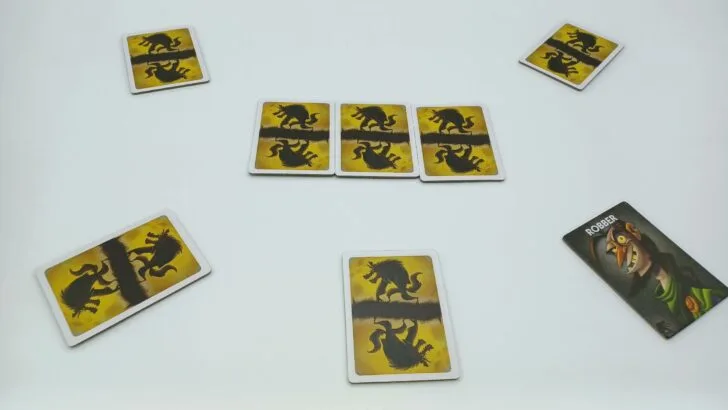
To end your turn as a robber, you will close your eyes.
Troublemaker’s Turn
The troublemaker opens their eyes. The troublemaker can choose to exchange the cards of two players. They cannot look at either of the cards that they exchange.

The Troublemaker ends their turn by closing their eyes.
End of Night Phase
The announcer should then slightly move all of the cards on the table while keeping their eyes closed. They should do this so players can’t make any claims saying that someone moved their card during the night phase.
The night phase ends with all of the players opening their eyes.
Day Phase in One Night Ultimate Werewolf
Once the day phase has started the players will discuss their suspicions about what happened during the night and which role they think each player has.
While discussing players can say anything they want which includes lying to the other players. At no time may you show your card to the other players.
Since some of the roles have players moving cards around, players’ roles may have changed during the night. A player’s role is the card that is in front of them at the start of the day phase.
You can choose to use the role tokens as players discuss and figure out what roles specific cards must be. You can place a token on top of a card if the players are pretty certain what role the card is.

Once all of the players are done discussing their suspicions, the players will vote. At the count of three all of the players will point to the player that they want to vote out.
The player that receives the most votes dies and is eliminated from the game. If multiple players are tied for the most votes, all of the tied players are eliminated. Should no player receive more than one vote, no one is eliminated. All eliminated players show their cards to the other players.
Winning One Night Ultimate Werewolf
Once the voting and any eliminations are completed, the players will determine who won the game.
The villager team can win in one of two ways.
First if the players vote to eliminate one or more players with the werewolf role, all of the village players win the game. The villagers can still win the game even if they also eliminate another villager along with a werewolf.

Otherwise the villagers can win the game if none of the players are a werewolf, and they don’t vote out any players.

The werewolf team wins the game if at least one player is a werewolf, and no werewolves were voted out of the game.

Roles of One Night Ultimate Werewolf
Once you are familiar with how to play the game you can start to use some of the other roles. You can choose any combination of role cards to add into the game. You should always have three more cards than players though so some cards remain in the middle of the table. So players know what roles are in the game, you should put the corresponding role tokens in the middle of the table.
The wake up order of the various roles are as follows:
- Dopplegänger
- Werewolves
- Minion
- Masons
- Seer
- Robber
- Troublemaker
- Drunk
- Insomniac
- Dopplegänger/Insomniac

Dopplegänger
The Dopplegänger role is unique because it mimics the other roles. They will wake up first during the night phase. The Dopplegänger chooses another player’s card and looks at it. They will then place it face down in front of the player they took it from. The Dopplegänger then uses that role for the rest of the game. Depending on what role they saw, they may take a special action.
- Villager, Tanner, Hunter – the player takes on the corresponding role, but takes no special action at night.
- Werewolf, Mason – They wake up at the same time as the other players of the role they picked up. The player becomes a member of the team of the role they assumed.
- Seer, Robber, Troublemaker, Drunk – The player takes the corresponding action immediately instead of waiting until the time when the role normally takes their action.
- Minion – During the game the announcer will announce that the dopplegänger should keep their eyes open at the end of their normal turn if they are the minion. The werewolf players will then put up their thumbs to show the dopplegänger who they are. The player then becomes a member of the werewolf team.
- Insomniac – After the normal insomniac finishes their turn, the dopplegänger looks at their own card to see if they are still the dopplegänger.

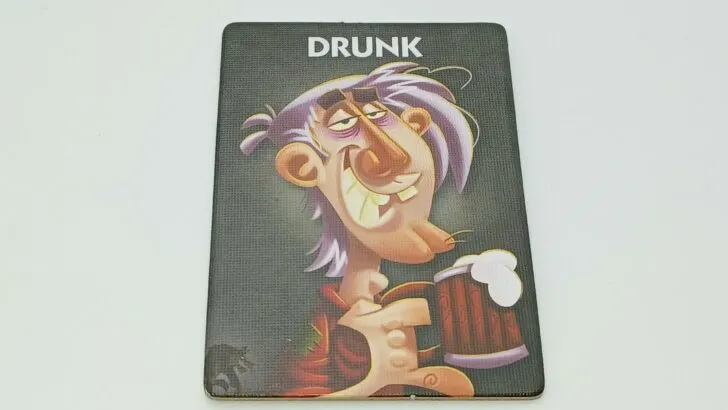
Drunk
During their night action the drunk player randomly swaps their role card for one of the cards in the middle of the table. They cannot look at their new role card at any time. The drunk player now takes on the role they swapped their card for.

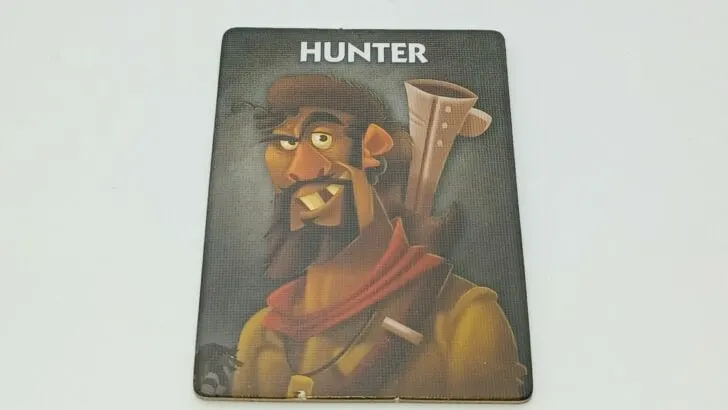
Hunter
Should the players vote out the hunter, the hunter immediately eliminates the player they voted for no matter how many votes that player received.

The hunter is part of the village team.

Insomniac
The insomniac uses their night action to look at their own card. This allows the player to see if they still have the insomniac card. You should only use the insomniac role if the robber and/or the troublemaker are in the game.
The insomniac is on the village team.

Mason
When you use the mason role you need to put both mason cards in the deck.
During the mason’s turn during the night, they will open their eyes. If they see another player with their eyes open, they know that player is also the mason. If they don’t see another player, they know the other mason card is in the middle of the table.
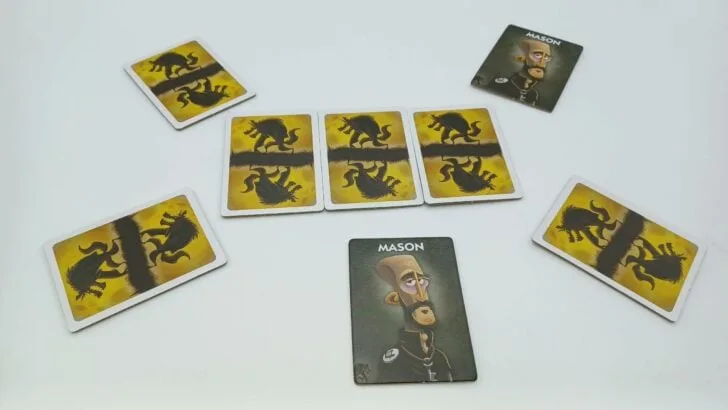
The mason role is on the village team.

Minion
The minion takes their turn right after the werewolves turn. When they open their eyes, all of the werewolves (eyes closed) will put their thumbs up to indicate their role. Therefore the minion knows who the werewolves are, but the werewolves don’t know who the minion is.
If there are werewolves in the game the minion can win the game even if they are voted out. Should none of the werewolves be eliminated, the minion wins along with the werewolves.

If there are no werewolf players, the minion wins if any other player besides themselves is eliminated.

Robber
When the robber takes their action they can choose to swap their robber card with the card in front of another player. The robber then looks at their new card. They do not take the action of the role they swapped for. See the Robber’s Turn section above for an example.
The robber player can choose not to swap their card. In this case they remain the robber.
The robber is part of the village team. If the robber swaps with a card that is on the werewolf team though, they will switch to that team.

Seer
During the night the seer can choose to either look at one player’s card, or they can look at at two of the cards in the middle of the table. They can only look at the cards, and must return them to their previous position after looking at them. For an example see the Seer’s Turn section above.
The seer is on the village team.

Tanner
The tanner wants to be voted out during the day phase. They do no take any action during the night phase.
If the tanner only wins if they are voted out during the day phase.

Should the tanner be eliminated but no werewolves are eliminated, the werewolves do not win the game.
If the tanner is eliminated along with a werewolf, the village team wins along with the tanner.
Should the tanner be eliminated and all of the werewolves are in the middle of the table, the village players lose.

Troublemaker
When the troublemaker takes their turn, they can choose to switch the cards of two other players. They do not have to swap cards if they don’t want to. See the Troublemaker’s Turn section above for an example.
The two players who cards are swapped are the roles of their new cards. They don’t know what their roles are though as they don’t know that their cards were swapped.
The troublemaker is on the village team.

Villager
The villager has no special ability in the game, and is on the village team.

Werewolf
During the night all of the werewolves will open up their eyes at the same time. This allows the werewolf players to know who each other are. If you don’t see another player with their eyes open, you know that you are the only werewolf currently in the game. The other werewolf card is in the middle of the table.
You can choose to use a variant rule if one of the werewolf cards are in the middle of the table. The werewolf player can look at one of the face down cards in the middle of the table.
Werewolf players are naturally on the werewolf team.
One Night Ultimate Werewolf FAQ
If you have any questions about how to play One Night Ultimate Werewolf, leave a comment below on this post. I will try to answer any questions asked as best and as quickly as possible.
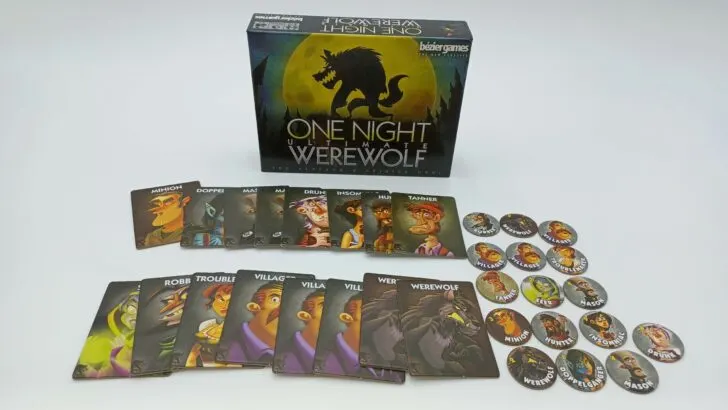
One Night Ultimate Werewolf Components
- 16 cards
- 1 Dopplegänger
- 2 Werewolves
- 1 Minion
- 2 Masons
- 1 Seer
- 1 Robber
- 1 Troublemaker
- 1 Drunk
- 3 Villagers
- 16 Role Tokens (same distribution as cards)
- Instructions
Year: 2014 | Publisher: Bézier Games | Designer: Ted Alspach, Akihisa Okui | Artist: Gus Batts
Genres: Deduction, Party
Ages: 8+ | Number of Players: 3-10 | Length of Game: 10 minutes
Difficulty: Light-Moderate | Strategy: Moderate | Luck: Moderate
For more board and card game how to plays/rules and reviews, check out our complete alphabetical list of board game posts.

